“There ain’t no sin and there ain’t no virtue. There’s just stuff people do.”
—John Steinbeck, The Grapes of Wrath
Perhaps no dusty desert town from the 19th Century exemplified Steinbeck’s quote better than Daggett, California. Shootouts, saloons, hangings and frontier justice, the old town had it all.
Early Daggett was a lively camp in the 1880s when nearby Calico was producing silver and borate. Like many desert towns of the era, it was distinctly a man’s town.
About eight miles from the future town site of Barstow, alongside the Mojave River, Daggett attracted many men who were seeking their fortunes in the nearby hills.
Silver was the prize at first, and when the silver began to peter out, it was Borax. As we know from our earlier story about Jerome, Arizona, we know what followed the miners.

Yep, you guessed it. Just like train cars following a steam engine, drifters, blacksmiths, bar keepers, promoters, gamblers, bawdy house girls and other old west regulars soon arrived in Daggett. Well before the 20th Century, Daggett was about to get wild. To some degree, it’s stayed that way to this very day.
Once called “Calico Junction,” Daggett was renamed in 1883 after then Lieutenant Governor John R. Daggett, owner of the Bismarck Mine in the Calico Mountains. Mr. Daggett developed the first ore mill for the mines a little between his namesake town, and the area we now know as Yermo.
There were no mines at Daggett; it served only as an outfitting center for the mines and for shipping ore. Primarily because of the mines, and objectively because the river was there, the people came. Water solved so many problems in the desert.

Because of the Mojave River’s sandy soil, it is capable of causing “flash floods” during cloudbursts. In 1901, four individuals, including Theodore Strong Van Dyke and his son Dix Van Dyke, formed a new company and started to improve the old dam and line the old Daggett Ditch.
Through their efforts, they were able to bring irrigation to 320 acres of new farm land east of Daggett (including the Van Dykes’ ranch) by 1902. This was the first large area to be irrigated in the Mojave Desert. There were fish in it in the 1950s and it was still in use into the 1970s. Also known as Mineola Canal and the Wind and Water ditch.
It was a site suitable for a rendezvous, reminiscent of the days of trappers and explorers. Here the men could relax when they came in from the mines where they worked hard and long. Here they could go for a spree if that was what they wanted, and no one thought anything about it one way or another. An 1893 article from the Savannah Courier (Savannah, Tennessee) paints a colorful picture of life in those rugged days of yore.

The famous 20 Mule Team Borax trademark was named after the method of hauling borax across the desert to markets east. For several years, Daggett served as the terminal of the real 20 Mule Team.
Two hundred men worked in the borax mines and mills. Daggett was a supply point for the borax fields in Death Valley as well for the Calico borate mines, and its former silver boom. Barstow was only a railroad stop and division point then, and Victorville, about thirty miles toward Cajon Pass, was then mainly a cattle grazing area.
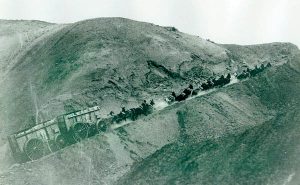
“The desert borax wagons are a marvel of themselves. The wagon proper is made to hold ten tons of borax. It has a bed sixteen feet long by four feet wide and sides six feet high. The hind wheels are seven feet, and the front wheels five feet, in diameter. They are fitted with tires eight inches wide and an inch thick, and an empty wagon weighs seventy-eight hundred pounds. In addition to this combined weight of wagon and load, amounting to about fourteen tons, is the trailer, as is called the water wagon, which it is necessary to attach to the train in order that man and beast may not perish of thirst on the journey. Altogether, the plucky teams have to haul through the yielding sands about twenty tons—nearly or quite one ton to the beast.
A traction engine is also employed in hauling the product of the mines. This is a huge concern weighing hundreds of tons and doing the work of several mule teams. This machine has not been found adapted to all features of the work, however, and is not destined to supersede the mule wagons.
A little more than twenty years ago borax was worth, in this country, in the neighborhood of one dollar per pound. It is now being mined,—even under the present disadvantages,—prepared, and marketed at a profit at about ten cents a pound, with a prospect of still lower figures in the near future.”
~ The Mystic Mid-region: The Deserts of the Southwest by Arthur J. Burdick, 1906.

“When brought to the works at Daggett, the lumps of borax are fed into the mammoth iron jaws of a crusher which breaks them into lumps of an uniform size about the bigness of the average chestnut. These lumps are fed to the grinder, which reduces them to powder, and the powder, in turn, is passed through rollers like those used in the manufacture of the finest grades of wheat flour. From these rollers it comes forth as fine as the product of the wheat from which our most choice bread is made. Then it is mixed with carbonate of soda, which is mined in Death Valley, and the mixture is thrown into vats of boiling water and agitated by means of revolving wheels till the mass is dissolved and thoroughly mixed. From this compound are precipitated two powders, one the borax of commerce, the other the well-known product styled sal soda.” ~ The Mystic Mid-region: The Deserts of the Southwest by Arthur J. Burdick, 1906.
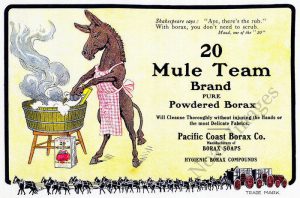
The Southern Pacific Railroad, along with the Atlantic and Pacific Railroad (later the Atchison, Topeka and Santa Fe Railroad and BSNF) from Mojave was completed in the area in 1882. It soon became apparent the name of Calico Junction was confusing, as it was next to the neighboring town to Calico where silver was being mined.
The ATSF moved to Barstow because property values became too high during the silver boom. Otherwise, Daggett would have become the main station and heavy rail yard of the area. In 1903, the Pedro, Los Angeles and Salt Lake Railroad, later the Union Pacific Railroad, also built their line from Las Vegas through Daggett. They were serviced at the roundhouse in Barstow.

Both railroads were 3 ft gauge, and both were serviced by two steam “pufferbilly” locomotives each. But after 1910, both of these railroads were closed down and abandoned due to the mining companies moving on to greener pastures found to the north in Death Valley. The old railroad beds can still be traced in some places in the desert, but now most of the old grades have been paved over to support cars and off-road vehicles.

Railroad tracks were the center of a 400 foot right-a-way that divided the town. The south side was the residential area–the business firms took the north side. In its peak there were about 50 homes and shacks. Most of them were made of rough boards standing on end, with slats nailed over the cracks. Only a few were ever painted.
Some of them were finished inside with cheese cloth covered with paper. The desert can be a windy country, and the early settlers must have had their tenacity tested in the thrown-together shacks with no means of shutting out the wind which can penetrate the smallest crack.
Whiskey barrels served as water tanks for domestic use. Water was pumped from a well in the river. The pump operated only two hours a day, and if one forgot to fill the house tank it was most unfortunate.

The Daggett garage began life in the 1880s at the borax town of Marion, located on the northeast shore of Calico dry lake, as a locomotive repair workhouse for the narrow-gauge Borate and Daggett Railroad.
Daggett blacksmith Seymour Alf used a 20 mule team to move the building to the Waterloo Mill in mine, southwest of Calico, circa 1896, where it served a similar purpose for a silver ore narrow-gauge railroad.
Walter Alf, Seymour Alf’s son, moved to the building to its current location in Daggett circa 1912. The building was an auto repair shop on the National Old Trails Highway until World War II, when it became a mess hall for the United States Army troops guarding the local railroad bridges.
The Fouts brothers bought the building in 1946 and operated an automotive garage and machine shop in the building until the mid-1980s. The building is currently owned and operated by the Golden Mining and Trucking Company. Historical marker information courtesy of HMdb.org
There were the usual saloons, stores and restaurants of a mining camp. Dingy rooming houses had beds that sold for 50 cents a night. There was a drug store, a barber shop, and the inevitable livery stable. Animals came and went, roaming the area; there were always dogs straying about the town, and pigs rooted everywhere.
A low branched pepper tree stood in front of the Mike Walsh Saloon where the cronies of the town gathered to exchange gossip. Here the loafers sat daily and spun their tales of the mines, the road, and their opinions of life in general and the desert in particular. The group was called “The Pepper Tree Club”.
They enjoyed their place in the sun as they sat hopefully waiting for hand-out drinks the proprietor often furnished. He realized very little profit from the clubsters, but joined them occasionally, since some of them he had known for a long time. All he asked is that they behaved.


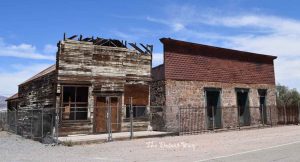

An evangelist eventually came to Daggett, for it was a town without churches, and he was greatly grieved. He held his services in the schoolhouse. The meeting was well attended and the people were generous with their money. When he asked for all who had been saved to stand up, no one stood.
The minister denounced the sins of the world and asked for those who wanted to be saved to stand up. Again, no one stood. It was too much for the evangelist and he left the next day, labeling Daggett as the worst town he had ever known.
But the truth is, Daggett was never really bad.

In 1901, John C. Van Dyke published a landmark book, The Desert, the first volume to counter the common wisdom of the day condemning deserts as ugly wastelands. Instead, with a poetry and power not since surpassed, The Desert praised the arid lands for their beauty, for their lava peaks that glow like hot iron after sunsets, and for their storms that whirl up in showers of gold.
Van Dyke did not actually make it out to the desert West until he was 43 years old. Both he and his older brother Theodore suffered from an unknown respiratory ailment, and years prior Theodore had “gone native” and relocated to a ranch near the rough and tumble mining town of Daggett.
Encouraged by his brother’s recovery, Van Dyke sought out the dry climate of the desert. A respected naturalist, author, rancher, all-around outdoorsman and Daggett’s justice of the peace, Theodore Strong Van Dyke prided himself as a personal friend and colleague of soon-to-be president Theodore Roosevelt and naturalist John Muir.
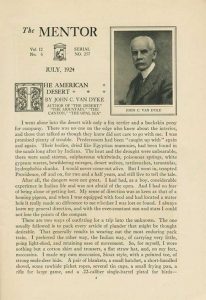
When twenty-two-year-old Dix Van Dyke arrived in Daggett, California, in 1901, the town was a wild and raucous frontier settlement, with barrooms and brothels, silver mines and land swindles, cattle drives, and shootouts at the Bucket of Blood saloon. Dix, a ranch-boy with no formal education but whose father and uncle were writers, became the town’s unofficial historian.
According to the records of Dix Van Dyke, everyone worked a seven day week. He said there were four holidays that were always celebrated: St. Patrick’s Day, Fourth of July, Thanksgiving and Christmas. According to Van Dyke, St. Patrick’s Day took precedence as there were many Irishmen in town. On that day they got everything they wanted of food and drink. He wrote, “It was a lucky hobo that got stranded in Daggett on that special day.”
Dix also reveals the Van Dyke ranch as an unlikely crossroads for intellectuals, some of them famous. Conservationist John Muir’s visits included one memorable argument with Dix’s Uncle John. Muir admirers may be surprised at the tangle of family relationships begun when daughter Helen married Daggett resident Buel Funk.

On March 3, 1910 Mary Beale wrote a letter to John Muir, one of the first nature conservationists and guiding hand behind Yosemite National Park, about a problem she had. At around that time Mary had contracted pneumonia and the effects of the disease left her with lingering health problems.
To help his friend, John Burroughs also inquired to Muir about the VanDyke Ranch in Daggett. Muir’s daughter, Helen Muir Funk, was in the same situation and found that desert living helped her. Helen Muir Funk’s home is now the home of the Augustan Society in Daggett.
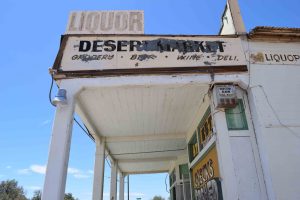
Later in 1910 Mary Beal moved to the Van Dyke Ranch. At first glance the rough town of Daggett was not a good fit for the shy Mary but she thrived there until shortly before her death in 1964. She first moved into a tent house at the Van Dyke Ranch. Tent houses, with wooden floors, walls and a canvas roof, were common temporary housing at the time.
Mary had an interest in plants since childhood so she turned her interest into a long standing passion. At that time there weren’t many books on desert plants so when William L. Jepson, a professor at the University of California at Berkley, published A Manual of Flowering Plants of California in 1925, Mary discovered her passion.
Mary got a copy and it soon became her bible and the book is still used as a source today. Jepson also became a friend and visited Daggett many times. Mary would also send her samples and notes to Jepson in Berkley and they are still part of the Jepson collection.
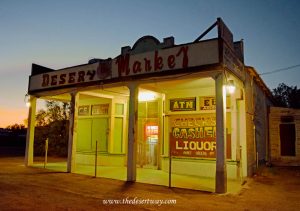

During the 1930s, Mary Beale hiked the Providence Mountains and identified several species of plants and wildflowers. Her friends, Jack and Ida Mitchell, built a road, trails and stairs where they led tours of limestone caverns. Yes you guessed it, named Mitchell Caverns.
Mary was also good friends with Minerva Hoyt, and the two were fervent desert explorers together. Hoyt, a southern belle from Mississippi, is remembered for her role in the establishment of Joshua Tree National Monument, now Joshua Tree National Park.
She went all over the desert to take pictures, get samples and study desert wildflowers even though she didn’t drive. In 1938 she won a photo contest sponsored by Desert Magazine. Mary had an article published in the magazine in 1939.
It is not known how she got the job of writing the articles but the fact that Desert Magazine editors and writers were frequent visitors to the Van Dyke Ranch might be the reason she got the gig. Mary wrote articles regularly for the magazine for 14 years when she had to stop because of health problems.

In 1953 Mary Beale’s passion was made into a trail when the Mary Beale Nature Trail at Mitchell Caverns was dedicated. Mary died in 1964. She was buried in a grave next to Dix Van Dyke in Daggett Pioneer Cemetery.


“A bitter wind was blowing over the Mohave,” says Linnie Marsh Wolfe, when an aging John Muir arrived at a desert ranch late in the winter of 1914. Most people know that Muir took sick with his final illness near an obscure desert town called Daggett. However, beyond that, little is known about his relationship to Daggett, to the Mojave desert, and to the friends he made there during the last seven years of his life.
Yet the period is rich with Muir’s personal involvement, with ironies, and his influence on others, and it is a period awaiting further exploration by students of Muir. A mountain and ice man, Muir didn’t go willingly to the California desert. Rather, it was the health of daughter Helen that forced him out there in his final years.
Muir lived on the Van Dyke Ranch, one mile East of Daggett. The ranch was owned by Theodore Strong Van Dyke, a well-known outdoor writer of the day who shared Muir’s sympathy for nature.


The old California Agricultural Inspection Station mentioned in John Steinbeck’s The Grapes of Wrath wasn’t Inspection Station #1 located right across the road from the ski lodge building like many believe. The inspection station made famous by John Steinbeck was actually inspection station #2, east of Daggett.
Inspection Station #2 was used until 1953 when a newer inspection station down the road replaced it. This was the third inspection station built in Daggett.
“…Daggett. Pop. 245, alt. 2006 ft. As you approach Daggett from the east, you will be stopped at the CALIFORNIA INSPECTION STATION, located at this point to check cars coming from the east. Here all westbound cars are stopped and careful inspection made to prevent unwitting importation of fruit and plant diseases and parasites.
The inspection is quite thorough: you will probably be asked to open all suitcases, untie all parcels, and unlock rear trunk compartments for inspection. The state has expressed regret at being compelled to make this inspection, but the great citrus and vegetable industries of the state make it imperative that a check be made. Even a few disease-bearing fruits or plants can multiply quickly. Keep the admission certificate they give you.
Daggett itself is a tree-shaded little old town that was formerly the location of smelters which handled the ore brought down from nearby mountains. Some of the old store buildings remain, but the town is now quiet. There are two trailer camps but no cabins. Cafes, garage and gas stations.” ~A Guidebook to Highway 66 by Jack D. Rittenhouse, 1946, page 118.
When the interstate replaced Route 66, the inspection station was moved to Needles on Interstate 40.



Another frequent visitor to Daggett was Death Valley Scotty, who claimed to have a fabulously rich gold mine at a secret location north of Daggett. Only decades later was it discovered that Scotty’s wealth came from an eccentric Chicago millionaire. The Old Stone Hotel, built in 1883, was once an “office” for Death Valley Scotty.
Other notables who stayed at the Stone Hotel are Lt. Governor John Daggett, John Muir (whose daughter, Helen, was a resident of Daggett) and “Borax” Smith. Prospector Frank “Shorty” Harris was also a frequent visitor to Daggett.
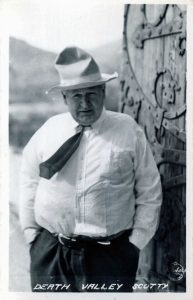

Please read our article about Shorty and pals at thedesertway.com/ballarat/
Bill Frakes was another colorful Daggett character, who tried unsuccessfully to breed coyote-killing sheep, and who prowled the wild river bottoms tracking real and imagined malefactors.
In 1930, the Barstow-Daggett Airport and Beacon became an important site of air aviation in southern California. By 1943, in the early years of World War II, the Daggett tower, because of its proximity to military operations at the Victorville Army Air Base, increased its workload 400 to 500%. By 1955, it was among the top ten busiest stations in the nation. It ended in 1961 when the airport was relocated.
Please read our article about the Barstow-Daggett Airport at thedesertway.com/barstow-daggett-airport/



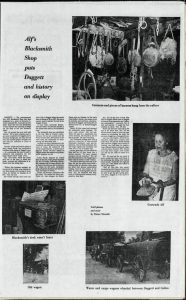

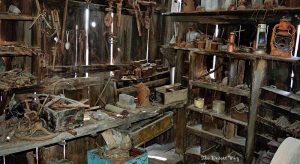
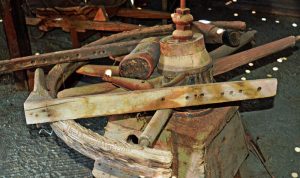
Nowadays, Daggett ghost town boasts a population of about 200. Daggett is a station on the BNSF Railway on the Needles Subdivision. Trains are frequent on the line as this line goes to Chicago. It is also a junction of the Union Pacific’s Cima subdivision, the former LA& SL line from Salt Lake City, and Utah via Las Vegas, Nevada. The UP runs via track rights on the BNSF and goes to Riverside, California.
County Service Area 40 provides television broadcast from Elephant Mountain near Daggett and Newberry Springs to a 100 square mile area encompassing Barstow, Daggett, Hinkley, Newberry Springs and Yermo. This CSA provides service to approximately 35,000 households and is funded by property taxes and rental income.
Daggett Museum has reopened on weekends from 1pm-4pm. The museum is located at 3370 Second Street in Daggett.
“The deserts should never be reclaimed. They are the breathing spaces of the West and should be preserved forever.” (The Desert 59)



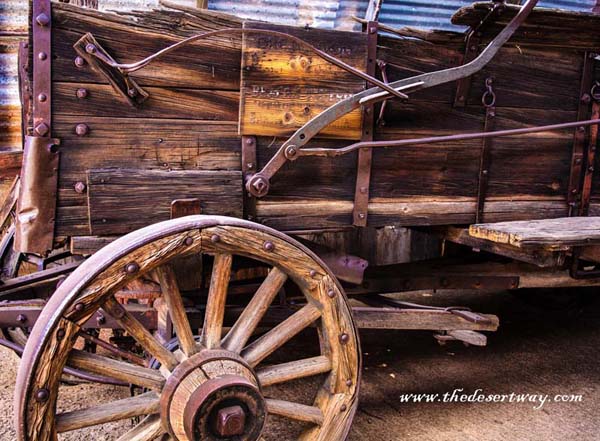

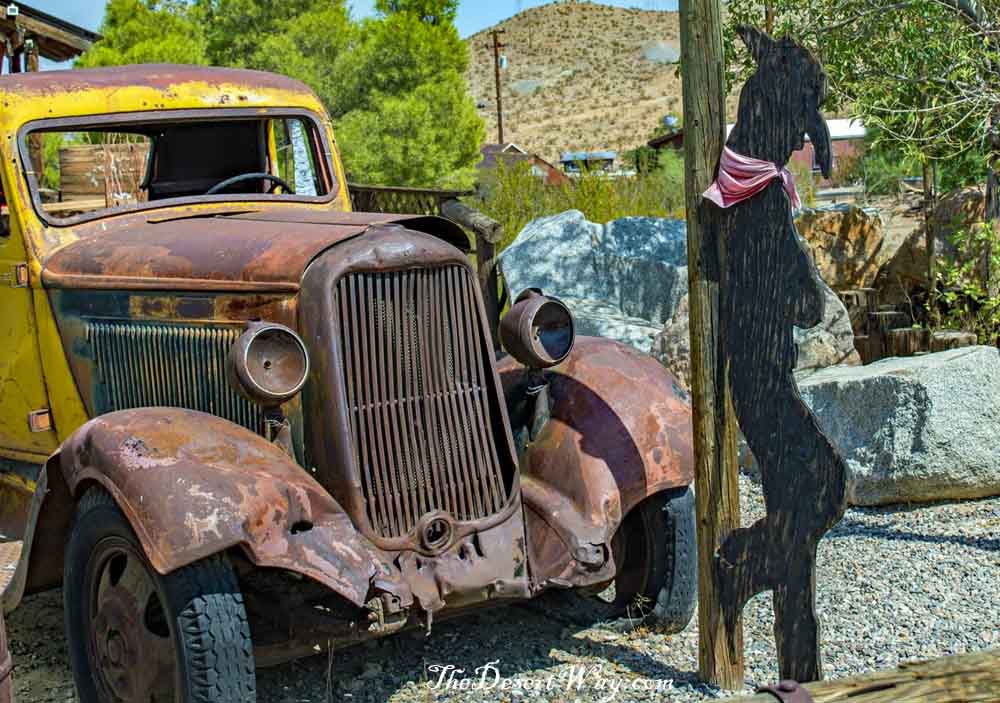

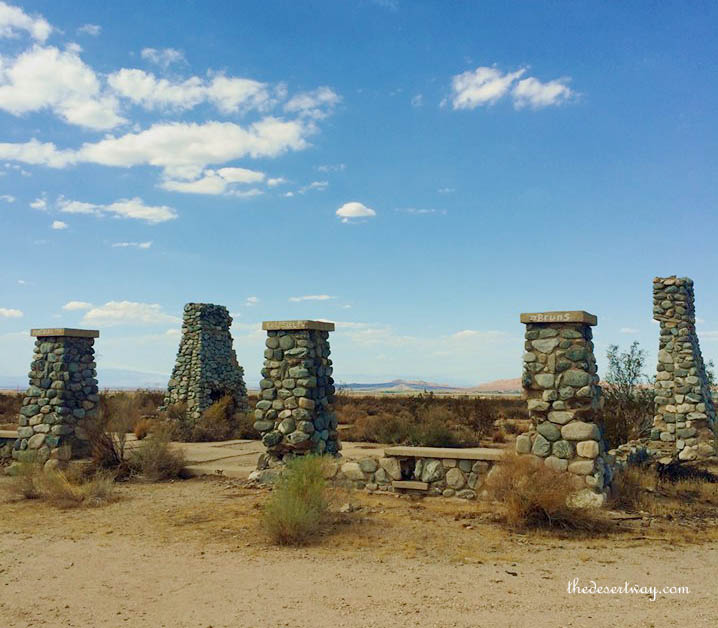
Very interesting article. Thank for historical information and it helps with some questions I have had over the years.
Thanks so much! Glad you enjoyed it.
Great article. Very comprehensive..Thank you so much. I grew up in the area and never realized all of this.
Thanks so much! We really appreciate your comments.
Brief stop there few years ago. Who knew!! Will be going back soon to be certain. Thanks for the great article. Well written and very informative.
Glad you enjoyed our article, Rob! Thank you so much. In the meantime, Daggett is awaiting your return. 😉
Love Daggett !!
The “Ski Lodge Building” is my grandmother’s house. Spent a great deal of my childhood there. Thank you or interesting read.
I am looking for information about my Aunt Marjory Phelps who owned coolwater ranch outside of Daggett . She and her husband Gray Phelps created guide a beautiful oasis there . I was born in 1950 and spent the first year of my life there returning for many summers .
Greetings,
I used to deliver newspapers there for a year or two. this would have been in 1961 and ’62.
I recall she had a very elegant home there,
I recall a huge pond there.
Barbara my name is LarryMcCune what is your name Barbara Borland please let me know I grew up on the ranch
Larry McCune sorry I couldn’t finish my comment got interrupted but I’ll leave my email I would like to hear from you thank you
I live just North of Daggett on Daggett-Yermo Road and I have part of the raised rail bed for the Calico-Daggett Rail line running through my property. Thank you for a very informative article especially with all the relevant pictures they’re what make your articles great as well as the writing, of course. I just found your blog and definitely will be spending more time reading as many articles that I can. Your work is appreciated.
My family and I lived in Daggett in around 1959 to ??. Our house burned down on Dec. 28 1959 our side of Daggett can’t remember much about it we lost everything. At the time my name was Linda Williams I think I went to kindergarten and maybe 1st and 2rd grade. my grand parents lived in Daggett also the Snedeker’s
Thank you for this informative article. It adds a new dimension to my travels on Route 66 in California.
I just had my first trip to Daggett as I was passing through.
I wish I had read your article first. Nicely done and thank you for taking the time to piece all the information together. That must have taken a tremendous amount of time.
As a past resident It was nice to see, my adopted home town, Job’s and divorce tore me away from there. Was one of the many owners of the yellow house across the freeway. that place seemed to have bad luck, but I loved it there. Wish some one could write a book for the Arcadia Press about Daggett, the material, hard to find is still there, though.
Just a quick correction: Yousuf (Joe) Khawaldeh runs the former George Mier general store. My great grandfather George Bertram Mier ran this store from 1881 to 1907 when he moved to Los Angeles. My grandfather Millard Moreland Mier lived the first twelve years of his life in Daggett.
My first visit to Daggett was during July 2021. It was an honor to meet Joe and to buy a bottle of wiskey from him. A great guy and I am so glad he is keeping the old family store alive!
My father started his business, Railgard (railcar repair shop) at Barstow-Daggett Airport 1981-1984 (approx). There is (or was) a railroad track north of the airport, that is where my dad’s business operated in that area. If you visit that area, you will probably find some “stations” right next to the track – to provide electricity for welding equipment. There was a mobile office building (but I believe it’s gone) in that area – that’s where my father worked. He was the President of the business.
I was about 14 at that time, I rode on my dirt bike around the airport (and at my dad’s business).
Excellent article. It’s full of information and things you would never think about. Times were not only tough but so were the people. It would be nice to see the same work ethic today.
Thanks so much, Laura. We really appreciate your comments.